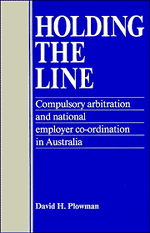Book contents
- Frontmatter
- Contents
- List of tables and figures
- List of abbreviations
- Acknowledgements
- Introduction
- Dedication
- 1 Industrial legislation and the rise of permanent employer associations 1890–1906
- 2 The Higgins era 1907–1920
- 3 Rival shops 1921–1929
- 4 Depression and recovery 1930–1939
- 5 War and government executive action 1940–1949
- 6 Consolidation 1950–1959
- 7 The National Employers' Associations 1960–1972
- 8 Confederation 1973–1988
- 9 Models of national employer co-ordination
- Appendices
- Bibliography
- Records of organisations
- Index
1 - Industrial legislation and the rise of permanent employer associations 1890–1906
Published online by Cambridge University Press: 05 November 2011
- Frontmatter
- Contents
- List of tables and figures
- List of abbreviations
- Acknowledgements
- Introduction
- Dedication
- 1 Industrial legislation and the rise of permanent employer associations 1890–1906
- 2 The Higgins era 1907–1920
- 3 Rival shops 1921–1929
- 4 Depression and recovery 1930–1939
- 5 War and government executive action 1940–1949
- 6 Consolidation 1950–1959
- 7 The National Employers' Associations 1960–1972
- 8 Confederation 1973–1988
- 9 Models of national employer co-ordination
- Appendices
- Bibliography
- Records of organisations
- Index
Summary
Employers devote resources to, and submit to the authority of, their associations only out of necessity. Historically, the need to form a countervailing force against unions has necessitated employer cohesion. The nature and longevity of that cohesion has, in turn, been influenced by the nature of the union challenge and the ability of unions to sustain that challenge. Where employees, because of legal, financial or economic circumstances, have been able to form only ephemeral organisations, employer organisations have also tended to be transient. Where longer lasting and more effective unions have come into being the relevant employers have had to organise with greater effectiveness. The first part of this chapter argues that the history of employer organisations until the Great Strikes of the 1890s was one in which such organisations existed only as long as the need to confront the challenges of unions existed. With the employer victories in that decade, and with the ensuing union decline, employer organisations also tended to succumb to financial and organisational decay.
Industrial legislation following the Great Strikes forced employers to form more permanent organisations to combat that legislation. This was particularly true of legislation providing for the enactment of compulsory arbitration. The nature of this legislation is reviewed in the second part of the chapter.
The third section reviews the organisational responses to the industrial legislation, with particular emphasis on the formation of state-bound employer federations and the Central Council of Employers of Australia.
- Type
- Chapter
- Information
- Holding the LineCompulsory Arbitration and National Employer Co-ordination in Australia, pp. 1 - 18Publisher: Cambridge University PressPrint publication year: 1989



